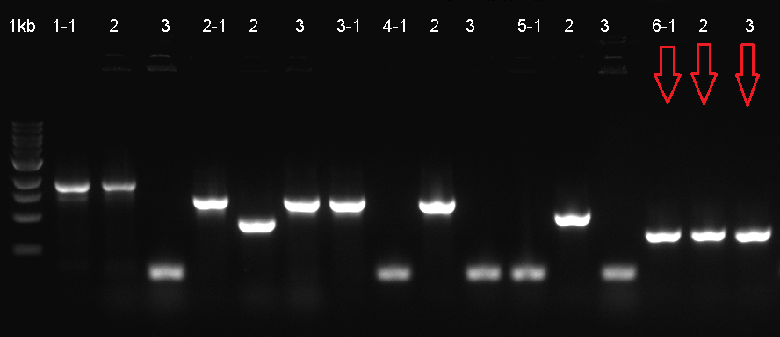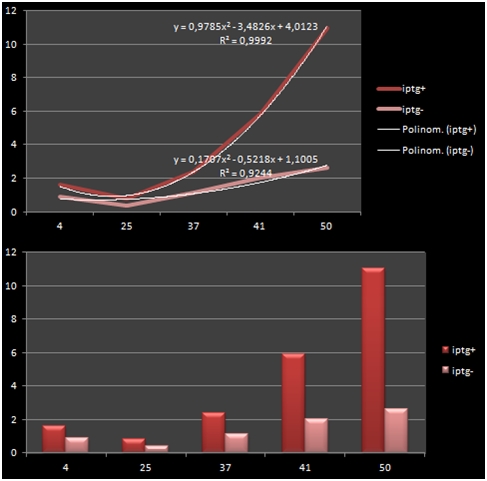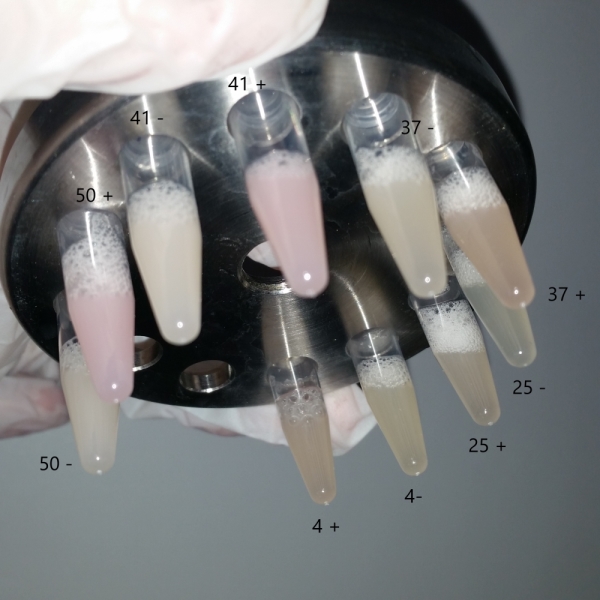Difference between revisions of "Part:BBa K1806004:Experience"
(→Cloning) |
|||
| (4 intermediate revisions by 2 users not shown) | |||
| Line 5: | Line 5: | ||
===Applications of BBa_K1806004=== | ===Applications of BBa_K1806004=== | ||
| + | == Cloning == | ||
| + | |||
| + | The composite system was ligated to the cloning vector psB1C3, to be transformated and then verified with Colony PCR. The verified ligation was then moved on to the digestion step to be cut with the EcoR1 and Pst1 restriction enzymes. The gel run of the cut parts were portrayed down below. The part was tagged as G-Block 6 and sample 6-2 yielded accurate results. | ||
| + | |||
| + | [[File:AUC TURKEY 6 colony.png]] [[File:6004-2.png]] | ||
| + | |||
| + | [[File:AUC_TURKEY_6,1,3cutcheck.png]] [[File:6004-4.png]] | ||
| + | |||
| + | == Functional Assay == | ||
| + | |||
| + | The bacteria that were transformated with G-Block 7 were cultured in 5 ml and incubated for 13 hours. After this incubation, the cultures were incubated at respective temperatures for 4 hours and were given 50uM of iPTG twice with 4 hours periouds. There were a total 5 different temperatures that the cultures were incubated in: 4, 25, 37, 42 and 50 C. The proteins in the cultures were then isolated and the protein concentrations were measured. Data on RFP concentration were acquired at 584 nm of emission and 607 nm of excitation. The acquired values were divided to the total amount of protein to acquire the following ratio. | ||
| + | |||
| + | {| border=1 align=center class="wikitable" | ||
| + | |+ align="bottom" style="caption-side: bottom" | Tabled Data of the Protein Analysis | ||
| + | ! Medium Temperature | ||
| + | ! iPTG Presence +/- | ||
| + | ! Total Amount of Protein | ||
| + | ! RFP Fluorometric Measurement | ||
| + | ! RFP/Total | ||
| + | |- | ||
| + | | 4 | ||
| + | | + | ||
| + | | 14.09 | ||
| + | | 22.32 | ||
| + | | 1.584 | ||
| + | |- | ||
| + | | 4 | ||
| + | | - | ||
| + | | 11.349 | ||
| + | | 10.36 | ||
| + | | 0.912 | ||
| + | |- | ||
| + | | 25 | ||
| + | | + | ||
| + | | 17.87 | ||
| + | | 14.35 | ||
| + | | 0.802 | ||
| + | |- | ||
| + | | 25 | ||
| + | | - | ||
| + | | 11.054 | ||
| + | | 4,313 | ||
| + | | 0,390 | ||
| + | |- | ||
| + | | 37 | ||
| + | | + | ||
| + | | 16.808 | ||
| + | | 40.2 | ||
| + | | 2.391 | ||
| + | |- | ||
| + | | 37 | ||
| + | | - | ||
| + | | 15.216 | ||
| + | | 17.36 | ||
| + | | 1.140 | ||
| + | |- | ||
| + | | 41 | ||
| + | | + | ||
| + | | 7.637 | ||
| + | | 44.83 | ||
| + | | 5.870 | ||
| + | |- | ||
| + | | 41 | ||
| + | | - | ||
| + | | 5.557 | ||
| + | | 11.13 | ||
| + | | 2.002 | ||
| + | |- | ||
| + | | 50 | ||
| + | | + | ||
| + | | 5.463 | ||
| + | | 60.06 | ||
| + | | 10.993 | ||
| + | |- | ||
| + | | 50 | ||
| + | | - | ||
| + | | 7.997 | ||
| + | | 20.95 | ||
| + | | 2.619 | ||
| + | |} | ||
| + | |||
| + | [[File:6005 FA1.jpg]] | ||
| + | |||
| + | The graph shows the variance in density concentrations of RFP, caused as a result of the functioning of the iPTG Inducible Promoters in different temperatures. The functioning of the promoters increased cumulatively with increased temperatures. | ||
| + | |||
| + | [[File:20150910 104908ddxdfghc.jpg]] | ||
===User Reviews=== | ===User Reviews=== | ||
Latest revision as of 13:48, 22 September 2015
This experience page is provided so that any user may enter their experience using this part.
Please enter
how you used this part and how it worked out.
Applications of BBa_K1806004
Cloning
The composite system was ligated to the cloning vector psB1C3, to be transformated and then verified with Colony PCR. The verified ligation was then moved on to the digestion step to be cut with the EcoR1 and Pst1 restriction enzymes. The gel run of the cut parts were portrayed down below. The part was tagged as G-Block 6 and sample 6-2 yielded accurate results.
Functional Assay
The bacteria that were transformated with G-Block 7 were cultured in 5 ml and incubated for 13 hours. After this incubation, the cultures were incubated at respective temperatures for 4 hours and were given 50uM of iPTG twice with 4 hours periouds. There were a total 5 different temperatures that the cultures were incubated in: 4, 25, 37, 42 and 50 C. The proteins in the cultures were then isolated and the protein concentrations were measured. Data on RFP concentration were acquired at 584 nm of emission and 607 nm of excitation. The acquired values were divided to the total amount of protein to acquire the following ratio.
| Medium Temperature | iPTG Presence +/- | Total Amount of Protein | RFP Fluorometric Measurement | RFP/Total |
|---|---|---|---|---|
| 4 | + | 14.09 | 22.32 | 1.584 |
| 4 | - | 11.349 | 10.36 | 0.912 |
| 25 | + | 17.87 | 14.35 | 0.802 |
| 25 | - | 11.054 | 4,313 | 0,390 |
| 37 | + | 16.808 | 40.2 | 2.391 |
| 37 | - | 15.216 | 17.36 | 1.140 |
| 41 | + | 7.637 | 44.83 | 5.870 |
| 41 | - | 5.557 | 11.13 | 2.002 |
| 50 | + | 5.463 | 60.06 | 10.993 |
| 50 | - | 7.997 | 20.95 | 2.619 |
The graph shows the variance in density concentrations of RFP, caused as a result of the functioning of the iPTG Inducible Promoters in different temperatures. The functioning of the promoters increased cumulatively with increased temperatures.
User Reviews
UNIQa674452990ce7b13-partinfo-00000000-QINU UNIQa674452990ce7b13-partinfo-00000001-QINU






